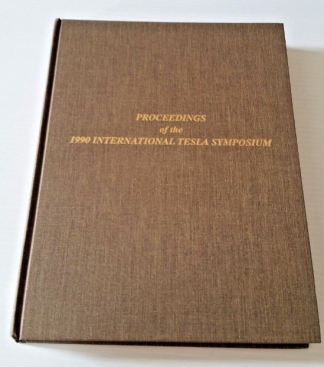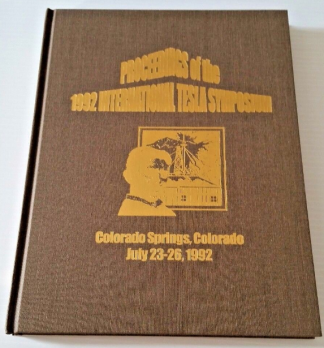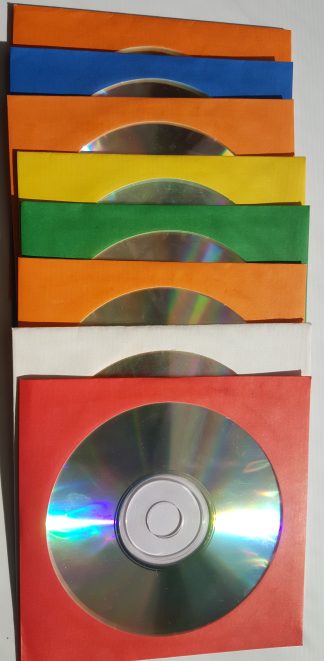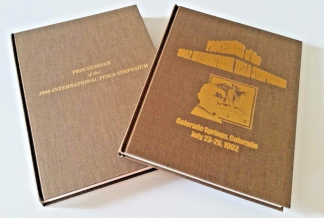Description
|
All of these incredible books offer valuable information from a number of genius inventors and scholars. From the 1990 Tesla Symposium Book: DESCRIPTION: TABLE OF CONTENTS:
EXCERPT: The Nikola Tesla MuseumAleksandar S. Marincic, D.Sc. Abstract The Nikola Tesla Museum in Belgrade belongs to the Belgrade Museum Union. It is both a memorial and a technical museum devoted to the life and work of Nikola Tesla. In addition to the exhibition area, the Museum has a library, archives, three office rooms and three store rooms. All of Tesla’s belongings, which were collected by his nephew after Tesla’s death, were transferred to Belgrade and from 1952 they have been kept in the Nikola Tesla Museum. A group of professors and younger staff from the Faculty of Electrical Engineering, University of Belgrade, produced the first Catalog of Documents with some commentaries. At the moment there are two electrical and one mechanical engineers working in the museum, but there are also several external experts with part-time or occasional engagement. External experts are involved in the preparation of material for publication and in the development of a new catalog in the form of a computer data base. Introduction Nikola Tesla is among the best known, if not the best known, Yugoslav of Serbian origin all over the World. In his native land Yugoslavia, he is a National Hero whose image and virtues never faded or diminished as the time passed by. What is even more rare, in this world of many ephemeral values and virtues, is his lasting contribution to science and technology and the freshness of his ideas even a century later. Like old Greek philosophers that initiated studies of the nature of fundamental structure and organization, Tesla was always keen on large scale problems. Even as a small boy he dared to think in an original way that puzzled his parents, teachers and friends. Throughout his long life he never ceased to puzzle at the World. In the first half of his life he gave a lot of practical proofs to his discoveries; in his later life he produced many ideas without proofs, but gave enough far-sighted material for his successors. When this big man died, his nephew Sava Kosanovich was in New York. Miss Charlotte Muzar, secretary of Mr. Kosanovich, who was at that time a Minister of the Yugoslav Government in Exile, wrote in her memo that on January 8, 1943 she was called to see Mr. Kosanovich in Tesla’s hotel room. She found there Mr. Kenneth Swezey, a locksmith and an unknown person. Police and government officials had already been there before she came. The famous Tesla’s safe was opened, briefly explored and locked again under a new code. Before leaving for London on July 25, 1944, Mr. Kosanovich went to a Manhattan warehouse to check Tesla’s belongings. After two years he returned to the United States as the Yugoslav Ambassador, and remained in New York until April 1950. After completing all formalities, Mr. Kosanovich sent Tesla’s belongings by ship the Srbija to Yugoslavia at the beginning of September 1951. In 1952 a nice building was found in Belgrade to become the Nikola Tesla Museum. It was officially established by the Government of Yugoslavia on December 5, 1952, and opened for visitors from October 20, 1955. Tesla’s ashes were in the United States until 1957 when Miss Muzar brought them to Yugoslavia. The transfer was done after Mr. Kosanovich had died on November 14, 1956 in Belgrade. Organization of the Nikola Tesla Museum Exhibition Part All of Tesla’s belongings are situated in a building of about 500 square meters on two levels. On the ground level is the permanent exhibition, divided into six rooms (Figure 1). The first room introduces visitors to the content of the Museum Archives, to letters of prominent scientists and some personal documents including a photograph of his native house with the adjoining church, in the village of Smiljan, where his father was a vicar.
Figure 1. The floor plan of the ground level permanent exhibition area. — Nikola Tesla Museum. When a visitor enters this room he has in front of him a bust of Tesla sculpted by Ivan Mestrovic and Tesla’s words about the exceptional profession of a researcher, his life motto. The second room is devoted to Tesla’s life in the United States. There are again a number of personal things as an illustration of his life style: an elegant crocodile leather bag, gloves, glasses, shaving bits and an embroidered bag, Licka torba, made by his mother (Figure 2). Numerous papers, photographs, letters and notes are displayed along with a number of instruments found among Tesla’s belongings. They might have had a special value to Tesla since he kept them until the end of his life. Unfortunately there is no evidence whether Tesla kept them in his room or somewhere else. Tesla had close friends who were writers and artists. Among them were Mark Twain and Robert Underwood Johnson whose photographs Tesla possessed. Tesla’s contacts with his native land, papers about his visit to Belgrade in 1892 and his letter written in 1942 supporting actions of American President against fascism are selected as illustrations of Tesla’s patriotic and humanitarian activities.
Figure 2. Some of Tesla’s personal possessions that are on exhibit in room 2. — Nikola Tesla Museum In a special room, the urn with Tesla’s ashes in a gold plated sphere shape is placed on a stone stand. With this, the Nikola Tesla Museum is not only a Museum but Tesla’s Mausoleum as well. The exhibition of Tesla’s research activities begins with his Fairy Tale of Electricity, (See Appendices) a short history of electricity written by Tesla himself and placed on exhibit in room 4 [1]. The group of Tesla’s patents devoted to the generation, transmission and utilization of polyphase alternating currents, from the period 1887 to 1890 are on display in room 5. These patents represent the foundation of present day power engineering. Tesla’s system initiated the second electro-technical revolution which changed the World, and even today we do not see any substitution for this system. The idea which the Museum designers had in mind in producing exhibits in room five was to create a small laboratory where one can easily explain Tesla’s induction and synchronous motors, polyphase generators, the idea and practice of rotating magnetic fields and the system of generation, transmission and utilization of polyphase currents. To make this part of the exhibition interesting, Tesla’s own original ideas were fully exploited. To explain the rotating magnetic field and the induction motor are attractive copies of Tesla’s egg of Columbus or the spinning egg (Figure 3), and Tesla’s hydraulic analogy. Working models of Tesla’s first induction motor and a small hydroelectric three-phase system clearly outline the basic ideas and practical value of the invention. The visitors are reminded here of the famous 1893 World’s Columbian Exposition in Chicago where Tesla starred in his own exhibition.
Figure 3. A model of Tesla’s Egg of Columbus, used to explain the rotating magnetic field and demonstrate the operating principal of the induction motor. — Nikola Tesla Museum The original nameplate from one of the first ten generators manufactured by the Westinghouse Electric and Mfg. Company for the Niagara Falls Power Company is a monument to Tesla’s achievement and a great attraction for visitors. In a corner of room five there is a model of Tesla’s bladeless turbine, bladeless fan and some bladeless revolution meters. These are illustrations of his work in the mechanical engineering field where Tesla tried to realize some ideas, presumably to get enough money to complete his wireless power transmission system. Tesla devoted twenty years of his life to these inventions, trying to improve and apply them in practice. Probably the most attractive room, with a high ceiling, is the one devoted to high-frequency and high voltage generators. With the new kind of transformer, patented by Tesla in 1891, well known as the Tesla Coil, high voltages in excess of several hundred kilo-volts are produced by two generators. One is built to resemble one of Tesla’s many original models. The other is capable of producing about half a million volts. It had to be designed with safety in mind due to restricted space and the danger of fire. The stray radiation produced by this apparatus is enough to perform an attractive wireless light experiment. Around the room there are several original photographs from Tesla’s New York and Colorado Springs Laboratory and a model of the four tuned circuits. Wherever suitable, original patents and notes are shown. A few pages from cases adjudged in the Supreme Court of the United States regarding the case of the Marconi Wireless Telegraph Company vs. the United States, about Tesla, Stone and Lodge priorities in the field of Radio are exhibited [2]. As is known, Marconi United States patent No.763,772, filed November 10, 1900 and assigned to the Marconi Company on March 6, 1905, was canceled. This was done after Tesla’s death in June 21, 1943.
Figure 4. An operating model of Tesla’s 1898 radio controlled boat, dubbed the Telautomaton. — Nikola Tesla Museum In the last room of the Museum, room 7, are shown Tesla’s experiments and achievements in the field of remote control. A small working model of a ship (Figure 4) is made according to the original patent of 1898. Accompanying extracts from Tesla’s famous paper published originally in the Century Magazine, The Problem of Increasing Human Energy, is one of many records of his far-sighted outline of the future regarding remote control systems [3]. It has recently been stated in the introductory of a modern computer book, that Tesla’s description in the Century Magazine article is in fact a rather precise definition of a modern process computer. After completing some moderate scale radio experiments, in his New York laboratory and more daring experiments in his Colorado Springs laboratories at the beginning of 1900, Tesla constructed a large object named the World System on Long Island. The enlarged photograph of the station antenna has dominant position in room seven. Tesla did not have sufficient resources to finish this plant in spite of desperate efforts to persuade J.P. Morgan and others to help him. That seems to be the direct cause for Tesla withdrawing from people and leading an isolated life. Although never fully rewarded for his work, Tesla received many recognitions from all over the World. The greatest among all of these is, undoubtedly, the one given to him posthumously in 1960 by the International Commission for Electrical Engineering, at its session in Philadelphia. That Commission decided that the unit of magnetic induction is to be named the tesla, T=Wb/m2. A few years ago several more recent papers about Tesla, written in various languages, were exhibited together with announcements about the Nikola Tesla Award established in 1976 by the IEEE. Among other documents are the IEEE anniversary stamps with Charles Steinmetz, Nikola Tesla, Edwin Armstrong and Philo T. Farnsworth featured. The exhibition ends with the posthumous mask of Tesla and words of the American inventor Armstrong: The World, I think, will wait a long time for Nikola Tesla’s equal in achievement and imagination. Archives and Library The whole inheritance of Nikola Tesla is situated on the first floor of the building. It includes his manuscripts and drawings, his correspondence with over 6,700 different persons, books and the valuable clippings from periodicals and newspapers which published articles about Tesla, or about scientific and technical problems he was interested in. The first document catalog was produced under the guidance of Professor Veljko Korac, Director of the Nikola Tesla Museum from 1952 until 1980, with the help of professors and younger staff from the Faculty of Electrical Engineering, University of Belgrade and the Museum staff. On the whole around 150,000 documents were registered. The documents are grouped as follows: NIKOLA TESLA’S LEGACY I. MUSEUM ARCHIVES II. MODELS OF TESLA’S EXPERIMENTS AND INVENTIONS III. CARD CATALOG OF TESLA’S DOCUMENTATION IV. NIKOLA TESLA MUSEUM LIBRARY V. INVENTORY OF THE NIKOLA TESLA MUSEUM NIKOLA TESLA’S WORK I. TESLA PATENTS A. U.S.A. patents II. ELECTRICAL ENGINEERING – HEAVY CURRENT TECHNIQUE A. Electrical generators III. HIGH FREQUENCY ENGINEERING – HIGH FREQUENCY TECHNIQUE IV. MECHANICAL ENGINEERING – MECHANICAL TECHNIQUES IN GENERAL V. TURBO MACHINES AND THERMODYNAMICS VI. AVIATION AND AIRCRAFT OR AERIAL VESSELS VII. TELEMECHANICS VIII. DISCHARGES AND OSCILLATORS IX. VARIOUS MATERIALS: CHARACTERISTICS AND TREATMENT X. ASTRONOMY A. Cosmogony XI. ILLUMINATION XII. LOCOMOTIVE HEADLIGHT XIII. LIGHTNING ROD XIV. WATER FOUNTAIN XV. APPLIED PHYSICS – OPTICS AND OPTICAL INSTRUMENTS, XVI. MECHANICAL OSCILLATORS XVII. MATHEMATICS, PHYSICS, APPLIED PHYSICS AND CHEMISTRY XVIII. COILS, CONDENSERS ETC. A. Ducts XIX. This number is not used. XX. ARTICLES XXI. VARIED PHOTOGRAPH LIBRARY Through use, it was found that the Catalog needed updating, translation into a foreign language and reorganization so that it could be searched in various ways. Due to financial problems the Museum never obtained proper equipment for microfilming and photocopying and the services of these kinds had to be made externally. With the help of the Tesla Memorial Society Inc, Lackawanna, NY, USA, a few years ago an IBM-PC was obtained and the Museum immediately initiated a program of making a new computer data base catalog. At the moment we can show some parts of the program. Pictorial presentation of Museum Documentation is organized in such a way that we start from the general menu and make appropriate selections from the screen:
After a group such as Archives – DRAWINGS is selected the next screen is:
The program maintains a data base consisting of more than 200 groups of documents which form a hierarchical tree structure and contain around 150,000 different documents. Groups not divided into further subgroups consist of a number of records each representing a card describing one document. A card is presented and stored in one of four different forms (record types) depending on the group it belongs to. For example, the most commonly used record type consists of fields: Card Number, Box Number, Folder Number, Date, Description, Title, Contents, Note, Key Words, Value and Condition. The five most prominent groups and subgroups are: The museum archives documentation, Tesla’s library, Tesla’s personal belongings, The exhibition objects and The museum library. First of these groups, the archives, is the largest group divided into many subgroups, containing around 125,000 documents concerning all Tesla’s technical and scientific work, biography, etc. The program uses a simple, self explanatory menu driven system, which enables the user to maintain the whole data base. After choosing the current working group the user can perform elementary operations such as adding new records (cards), deleting or changing existing records, viewing and printing contents in different forms. A password is obliged if the user wants to alter the data base in any way, so that unauthorized users cannot destroy the data. Complex queries enable the user to search the data base in aid to finding and viewing desired documents. Prompts are displayed in English and Serbocroatian languages. The program warns the user if a backup of entered data is not performed. As the data base is to grow quite large (up to 150,000 records, each around 2 KBytes long, making 300 MBytes), more convenient backup storage medium from floppy disks can be supported (eg. optical disks).
|












Reviews
There are no reviews yet.